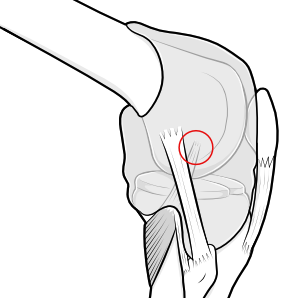Popliteus tendinitis is an overuse condition, where the attachment of the popliteus tendon to the lateral femoral condyle (bone on the outer side of the knee) becomes painful.
 Page updated February 2024 by Dr Sheila Strover (Clinical Editor)
Page updated February 2024 by Dr Sheila Strover (Clinical Editor)

Symptoms of popliteus tendinitis
Popliteus tendinitis (or tendonitis) causes pain on the lateral side of the knee, along the course of the proximal popliteus tendon and can be aggravated with resisted external rotation of the lower leg. It is rare and triggered by unusual or excessive exercise.
Sometimes crystals - like the ones found in gout - can be deposited in the tendon. Surgical excision of the crystals may remove the pain.
Management of popliteus tendinitis
Management of popliteus tendinitis is generally conservative, ie non surgical, consisting of rest and anti-inflammatory medication.
Sesamoid bone as a cause of popliteus tendinitis
There are reports of popliteus tendinitis due to a sesamoid bone in the tendon. A sesamoid bone is a normal structure where a bone exists within a tendon, like the patella and fabella.
If a sesamoid bone, in this case a cyamella, seems to be the cause of tendon irritation it usually does not affect the management, but on occasion a cyamella may be surgically removed.
-
Quote from peer-reviewed paper:
"Orthopaedic surgeons and general practitioners who encounter patients with persistent undiagnosed lateral knee pain should bear in mind the diagnosis of a cyamella....[where]....impingement of the popliteus tendon secondary to the cyamella....[can result in]....popliteal tendonitis...."
Citation: Rehmatullah N, McNair R, Sanchez-Ballester J. A cyamella causing popliteal tendonitis. Ann R Coll Surg Engl. 2014 Jan;96(1):91E-93E. doi: 10.1308/003588414X13824511649931. PMID: 24417852; PMCID: PMC5137648.
Forum discussions
- Re: I finally have my diagnosis
A runner discusses a snapping popliteus tendon.
 2012 -
2012 -